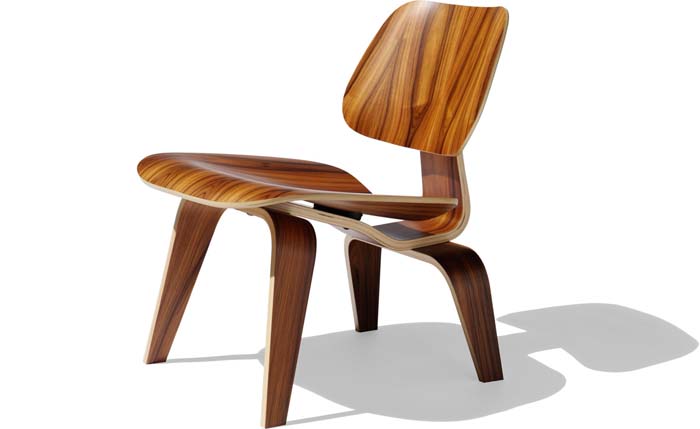
| Volume 33 #4 | January/February 2017 | |
 |
Greetings fellow dancers!
2016 is winding down to its final days, and a new year is about to begin. Of course, as dancers, we hardly notice such things. Even though the days are short and there’s more dark than light, we can always go dancing! And here in our area we have so many dancer-tunities – it’s great! Perhaps you don’t know, but in most places Scottish Country Dancing is definitely a once-a-week proposition.
The Betwixt and Between Dance and Ceilidh was great fun, with lots of great laughs both during the ceilidh acts and the dancing. What an enjoyable way to spend an evening. Not to mention how wonderful it is to see another side of our dancing friends – we are a talented lot for certain. And now the days are getting longer! Not really perceptibly so yet, but we trust that they are, and on the horizon, more dancing fun. The second Saturday in March, we have the Portland Branch Workshop and Ball. A workshop is a great way to improve your dancing in a day. I think it is the hours-long concentration on one thing that helps so much, or perhaps it is hearing some of the things your local teachers have been saying in another way, but somehow, at the end of a workshop you can feel that you have accomplished something.
Just beyond the Workshop and Ball in Portland, you can show off your new-found talents at our own Southwest Washington State Branch Dinner Dance. This year we will have Lisa Scott on piano and Deby Benton-Grosjean from San Francisco as our fiddler. This duo is dynamite, and if you haven’t heard them before, just coming to listen to the music will be a treat.
And if that wasn’t enough, the TAC Summer School will be held in Vancouver, BC this summer. It is a huge commitment of time and money, I realize, but with minimal travel expense, so worth considering. A week of dancing, enjoying the company of other dancers, and ah, the music! Lisa Scott will be the musical director for the week, which is awesome!
The Summer School runs from July 23-30th, and registration opens on February 15th. I expect it will fill up quickly, so try to register early. You can find out more about it here: https://www.tac-rscds.org/index.php.
A very Happy and Prosperous New Year to all, and Keep on Dancing!
Linda Mae
As many may know, we've three good and noble people from the Scottish community who were supporters of the Scottish dance community and former dancers.
Please remember the families of Maurice Baxter, Alexander "Sandy" MacKenzie, and Don Taylor Morrison this coming year in your thoughts and prayers and if you can think of ways to include them in your lives, certainly do so.
Here's a tribute from Alasdair Fraser for them: https://www.youtube.com/watch?v=bz68h5u4rD4
Subscriptions and views for DancieMaetion continue to grow. I believe most views come from YouTube, but there are also considerable downloads from our website: http://DancieMaetion.ImaginationProcessing.com
YouTube keeps good stats on viewers and I thought I would share some of those numbers here. For 2016 there have been over seventy one thousand views, up about fifteen thousand from last year.
Here is ‘views’ percentage breakdown based on the age and sex of the viewer:
 |
The statistics show clear popularity among the older crowd, split roughly between men and women. If you believe that there are significantly more women dancers than men you might be able to prove that men rely more on DancieMaetions disproportionately.
The most popular dances:
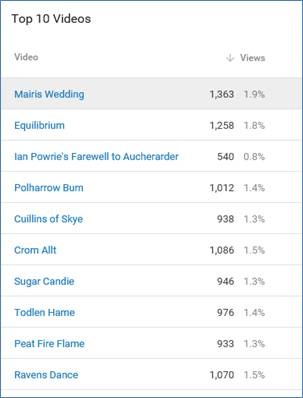 |
Views by country:
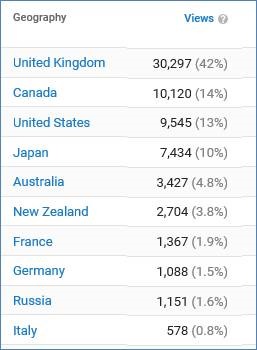 |
Helen McGinley climbed the narrow library ladder to retrieve an ancient volume. With practiced gentleness she opened “The Art of Dancing, Demonstrated by Characters and Figures,” to reveal hieroglyphic portrayals of dancing in the year 1706. A fascinating precursor to our own Pillings diagrams of Scottish Country Dance.
Helen, a Scottish Country Dancer in Dublin and employee of Trinity College, gave a private tour of the Long Room to Tom and me. Trinity College was established in 1592 in order to bring Ireland into the mainstream of European learning and to strengthen the Protestant Reformation within the country. Its Old Library also houses the Book of Kells, an illuminated Gospel manuscript believed to have been created around 800 AD. No photos are allowed, but we can see pictures of some of the pages here: https://en.wikipedia.org/wiki/Book_of_Kells
Many thanks to fellow-dancer Helen for enriching our visit to her fair city.
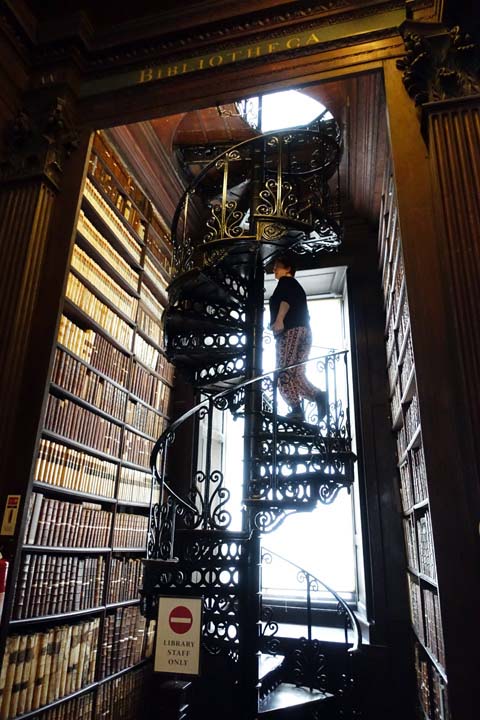
|
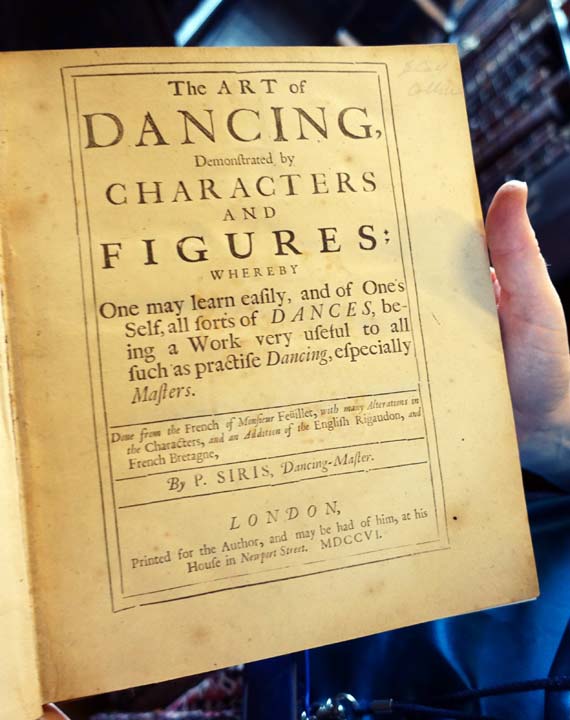
|
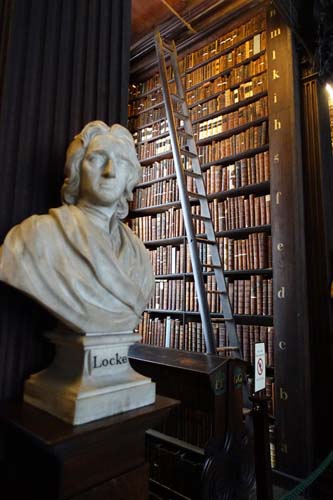
|
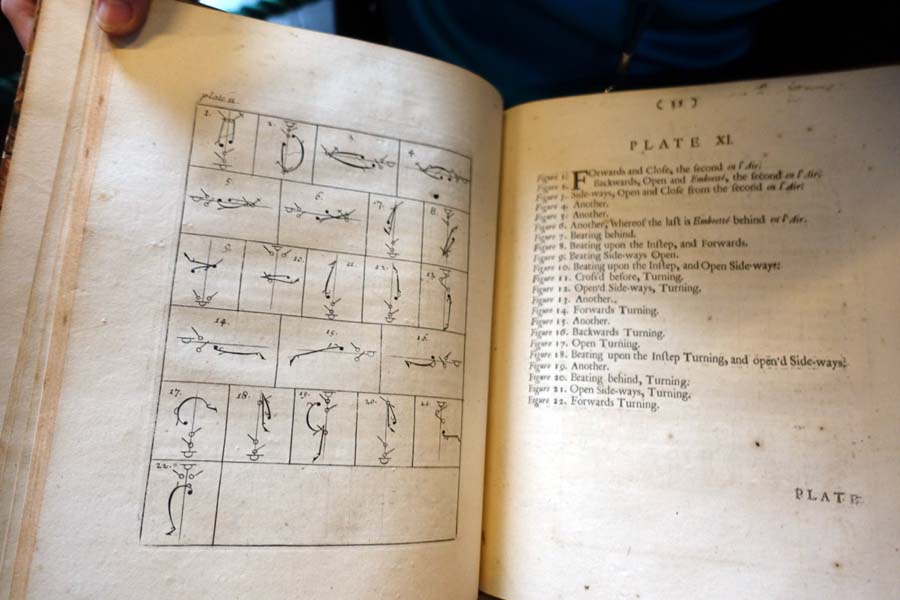
|
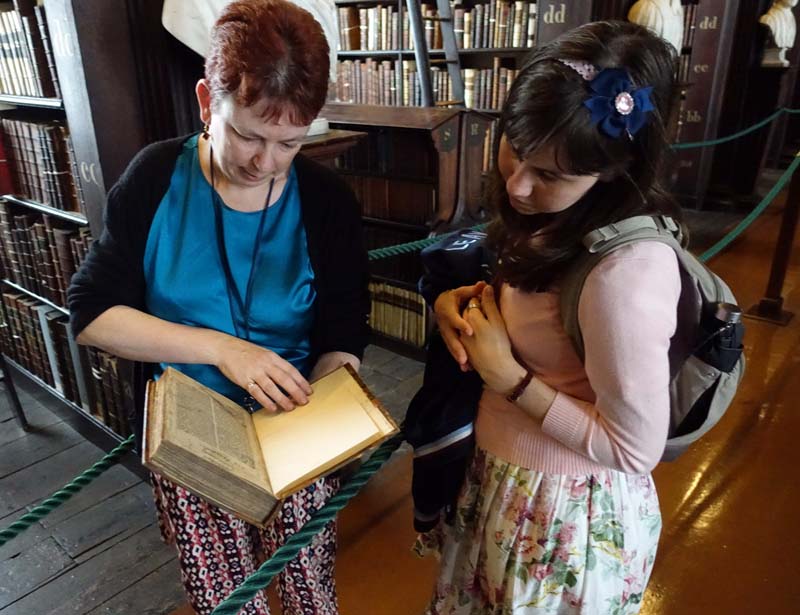
|
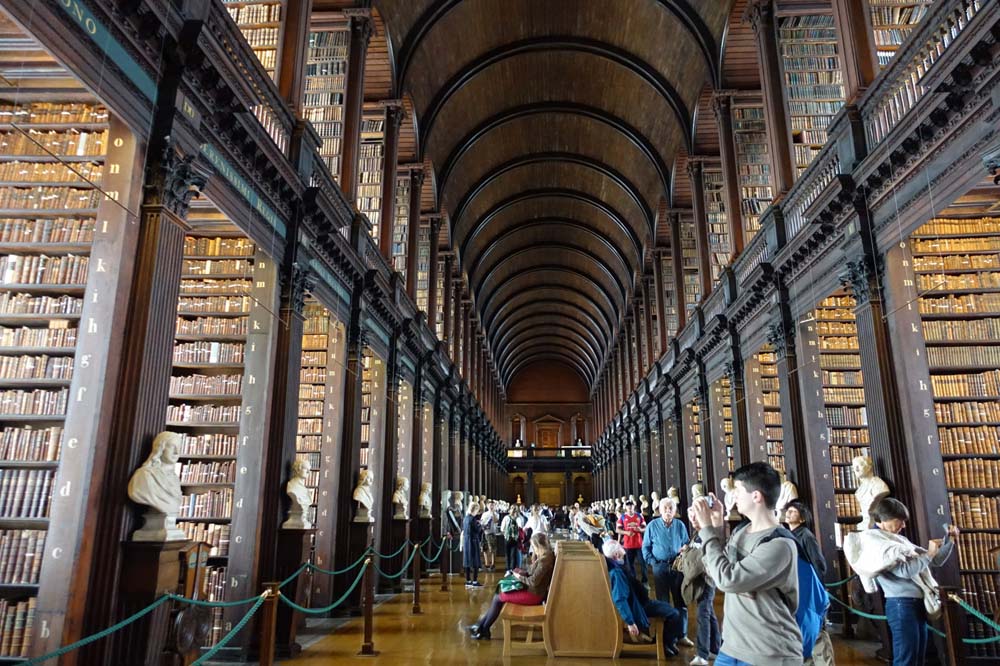
|
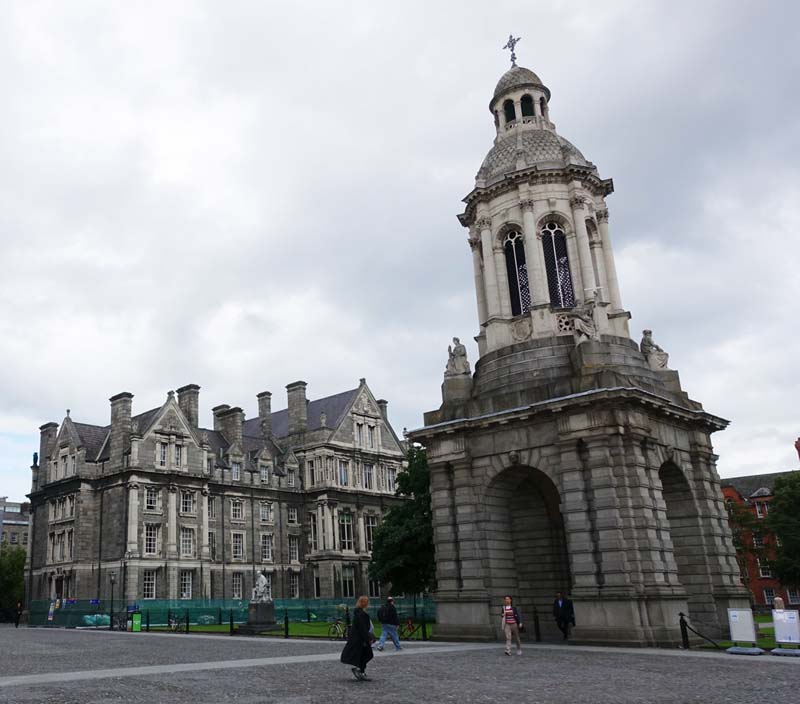
|
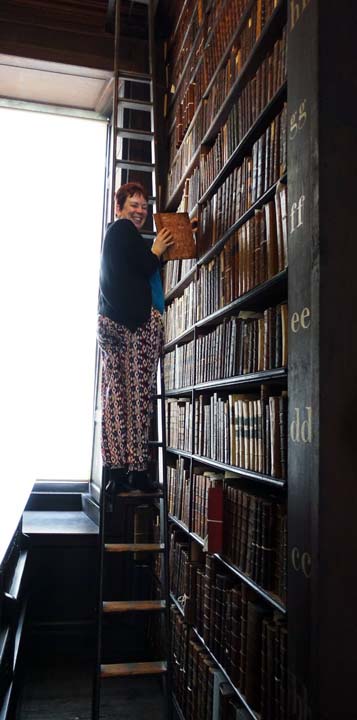
|
This last October 7 - 9, 2016, I decided to have another adventure. I have lived in Oregon for almost thirty years now, but I had yet to visit Sisters, Bend, or Redmond! To add insult to injury, I had not attended the popular annual High Desert Workshop & Ball. This was the twentieth anniversary, not-to-be-missed event!
I was fortuitously able to take a personal day off of work so I could travel with Martin MacKenzie and Holly Gibson that Friday. The sky was cloudy and gray, which is normal for October in Oregon, but it proved to be a lovely contrast for the vibrant fall foliage we passed along the way. We were well-trained by Holly to expect to stop at appropriate locations, which was not inconvenient.
We enjoyed stopping at the Detroit Lake Dam for photos and stretching. We also enjoyed a light lunch and espresso along the way. I did my fair share of “ooohing” and “aaahing” as we went. The sun decided to make an appearance when we reached the scenic town of Sisters. Even though the Ball was to be held there, we just passed through, as our final destination of that day was Fred’s house in Redmond.
There were other sites to see first, however. Dee Wright Observatory, along the McKenzie River, actually at the McKenzie Pass summit, was preeminent in our thoughts. This place was actually built of lava rock, and on a sunny day offers panoramic views of the Cascade Mountains. Unfortunately, we drove up into the clouds, but it was still amazing to see the observatory and so much lava! Martin and Holly explored the half-mile paved trail through the lava nearby. We saw several miles of lava flow after we left to continue our journey! For more information go to: http://thecentralcascades.com/
As we headed to Fred Kowolowski’s home, I recognized some road signs and realized I had actually been through Redmond before, although it was about thirty five years ago, and on Amtrak in the dark, to boot. In addition to Fred, at his home we were greeted by Tom and Liza Halpenny and John and Susan Shaw who had travelled separately. Sleeping arrangements were immediately apportioned, and as Martin and I had made plans to meet Jennifer Seelye at her business in Bend to join other dancers for a pre-ball walk-through, we dashed off.
Afterwards, Martin and I joined Jennifer, April Munks and her dad, Leonard, at the Oregon Spirit Distillery in Bend. Ironically, Martin and I had driven past a lot of distilleries in Scotland during the previous summer, but hadn’t found time to stop. Our table was right next to the large window view of part of the distillery, and we were visited by one of the owners! A couple of us used him as a cashier to buy some whiskey for the upcoming raffle. I also had my first Moscow Mule cocktail, which was pretty tasty and a nice accompaniment to our small meal.
The next morning came early and we traversed the Sisters Harvest Faire finding our way to The Belfry, a repurposed church, which was the Workshop and Ball location. We were taught by vivacious Marjorie McLaughlin from San Diego, CA. I enjoyed her interesting historical introductions to several of the dances she taught. Some of them apparently inspired Tom Halpenny to write an article about Hugh Foss in the previous newsletter! The High Desert Celtic Dancers were quite hospitable, treating us to a lovely lunch and friendly conversation.
Immediately after the workshop, there was a brief ball walk-through available, after which we headed back to Fred’s house to rest, eat and don our ball finery. On our drive back to The Belfry, we enjoyed the lovely sunset and enlisted Holly to take several pictures of it for us!
A couple of the dances at the Ball were appropriate to the location, The Three Sisters and Springs of Metolius. Of course there was the tribute to Marjorie McLaughlin, Round the Room Jig for Marjorie.
The Ball was quite animated, and I really enjoyed the musicians, A Scottish Heart with guest musician Steve Scott. The High Desert Society had a well-done intermission performance, combining some dances devised by Susie
Allely herself, High Desert Strathspey and The Oregon Tartan Reel. This can be seen performed at a different location at:
https://www.facebook.com/ScottishCountryDanceBend/videos/544900945699536/
The next morning came quickly, and we were treated to breakfast by Fred, himself, who prepared toast, eggs and bacon for all who wanted it. Afterward, we all said our goodbyes and headed homeward. Martin thoughtfully planned our direction to go through Smith Rock, and Holly was not averse to seeing and photographing facets of a different viewpoint. I met a forest ranger there who was relatively new to Oregon and had never been to the Portland area yet!
We made a few other stops along the way, e.g., a distant view of The Sisters and The Huckleberry Inn in Government Camp. I just had to order a slice of Huckleberry pie to go there, as my last tribute to my beloved huckleberry! I enjoyed the journey, even when the rain started as we got closer to Portland. I loved seeing the fall colors!!
In conclusion, an excursion to the High Desert is a worthy experience, and I’m glad I went!
Q: What did the Beltane Society have to do with Scottish country dance?
Friends of Don Morrison said goodbye November 26, 2016. Don began Scottish dancing about the same time as several of us in 1997. Don's wife Marie gave him the idea for a fun activity during his retirement. We had the pleasure of Don's company at many classes and dances over the years. Don presented the Vancouver USA Scottish Country Dancers with a banner at his 80th birthday party in 2004, to display at the group's public events.
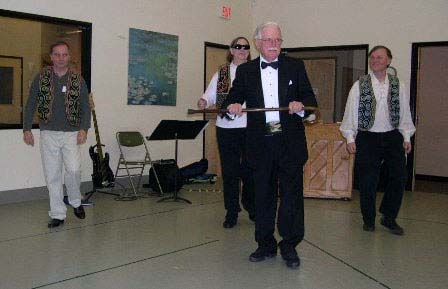 |
Don was the star dancer for the 2008 Betwixt and Between Celtic Tap performance.
Here is a video of Don having a fun time dancing at the 2010 Dinner dance.
https://www.youtube.com/watch?v=vmeSNqahtAo
Don liked to photograph Scottish dance activities. He prepared this video of the 2011 Betwixt and Between event for us to enjoy. https://www.youtube.com/watch?v=P-C_uFi2lc4
We can learn more about Don's life and his many interests from the obituary:
Dr. Donald Taylor Morrison passed on November 13,2016 at his home in Vancouver (Felida), Washington, surrounded by family, one week after suffering a stroke and aneurysm. He was 92 years old and died eleven days before celebrating his 67th wedding anniversary.
Donald "Don" was born July 9, 1924 in Port Townsend, WA to Dr. Albert Taylor Morrison and Alma June Austin Morrison, a nurse. The child of Public Health Service workers, he lived across the country including Valdez, Alaska (1926); Edmonds, Washington (1926); San Francisco, California (1927); and New York (1928) where his father worked on Ellis Island as a medical examiner for immigrants. They were later stationed abroad in Belfast, Northern Ireland (1930) where Don attended a French girls school. In 1933 the family moved to Warsaw, Poland before moving to Detroit, Michigan (1934); Seattle, Washington (1938); and Galveston, Texas. He was an Eagle Scout, graduating valedictorian from Ball High School in Texas in 1940.
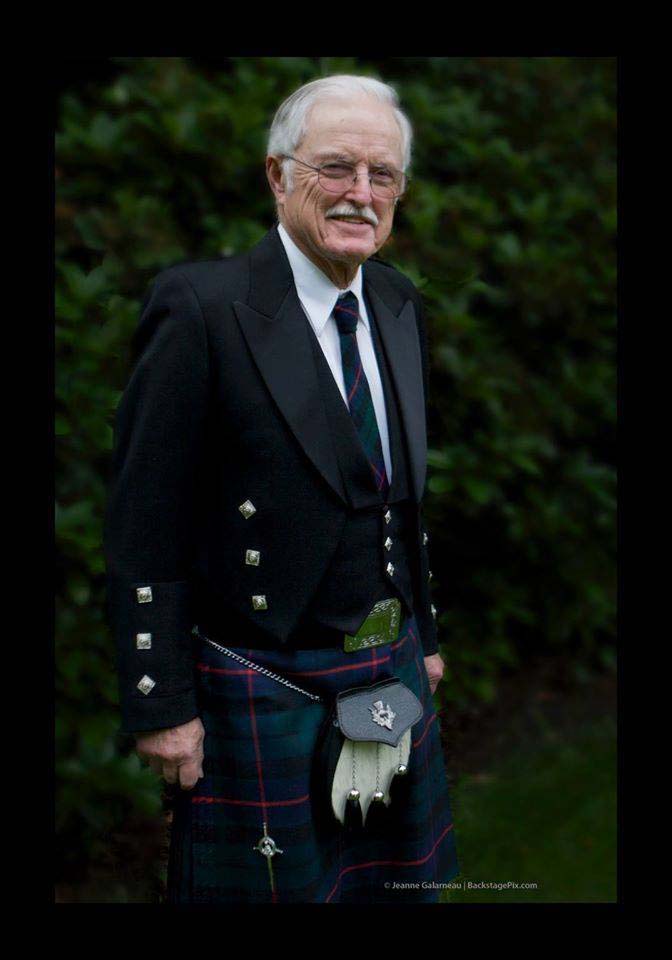 |
He received his undergraduate degree from Rice University in Houston and pursued a medical degree at Tulane University in New Orleans. He met his wife, Marie Louise Davies of Ponchatoula, Louisiana, while doing rotations at Charity Hospital. She was a senior student at Charity School of Nursing. He first asked her out to a dance on a dare from his fellow medical students. They were married November 24,1949. He received his M.D. degree in June 1950 and moved to Portland, Oregon, where he was a resident at Providence Hospital. The family moved to Hazel Dell, Washington in 1956 and eventually settled in Felida, Washington in 1968.
In his early 20s, Don served in the Navy, receiving a medical discharge after contracting tuberculosis. He served as a medic in the Korean War and spent a short time in a M.A.S.H. unit.
Qualified in Pathologic Anatomy, Don was licensed to practice medicine in 1956, and became a Fellow of the American Society of Clinical Pathologists in 1958, a Fellow of the College of American Pathologists in 1962 and certified as a Clinical Pathologist by the American Board of Pathology in. He was the director of the Medical Laboratory at Vancouver Memorial Hospital and directed NW Medical Laboratories in Northwest Portland for more than two decades. He and his wife, Nurse Practitioner, Marie Morrison, founded Hospice of Clark County in 1978.
 |
Upon retirement, Don developed a love of Scottish Country Dancing and was a member of the Royal Scottish Country Dance Society until the age of 88. In Felida, the family raised horses, ponies, peacocks, cows, Scottish Terriers, goats, and chickens. He was a classical pianist, photographer, wood-worker, gentleman farmer, avid skier, golfer, and an academic. He continued to bus and Max to Portland for medical conferences, relearned French, taught himself calculus, baked bread, made homemade jellies, and cared for his wife. He continually inspired his family and friends with his insatiable desire for knowledge, his soft, gentle kindness, generosity, subtle and witty humor, independence, and strength.
Don is survived by his wife of nearly 67 years, Marie Davies Morrison; younger siblings, Dr. Richard L. Morrison, and Carolyn (Kipper) Cowan; two sisters-in-law, Leslie Lauderback and Beverly Davies; five children, Elizabeth Gaile (Lara) Morrison, Donald A. Morrison (Suzan), Robert B. Morrison (Su), Jeanne M. Morrison Galarneau, and Susan R. Wolf (John); and granddaughters, Genevieve L. Galarneau, and Nicole R. Galarneau.
Liza and Tom visited Edinburgh Scotland in June and attended the Princes Street Gardens Scottish dance, below Edinburgh Castle. Compared with verbally briefing a dance, this video shows a team demonstrating one of the ten dances on the evening’s programme. After each demonstration, anyone who wants to can get up and try the dance. https://www.youtube.com/watch?v=m1_eL9C7-Yo
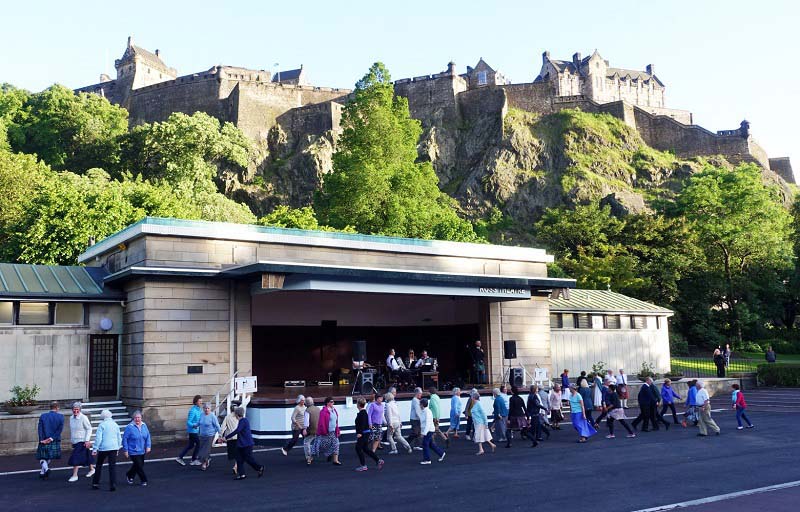 |
Law of Placement:
When you are in second place, hoping to watch once, second couple is the "dancing couple." When you manage to be in fourth place, it's a four couple dance and first and fourth couples begin. If you forget how the dance begins you are top couple.
Law of Briefings:
When you need a good briefing to clarify the dance in your mind, either the briefing will be especially confusing; or the MC will say there is no need for a briefing because everyone knows the dance!
So true! ~ The Editor
With this last report, detailing what I call the third and final leg of our journey, we travelled from Aberdeen, down the eastern seaboard of Scotland towards Perth, then on to Edinburgh for two days and back to Glasgow for the final flight home.
This was to be the final leg with the rental car and to me at least, this was the most like driving in the states than most all other journeys driving around Scotland. We largely travelled down the A90, a bit like a mini-freeway that goes down the east coast. There was a somewhat familiar reader board admonishing drivers to visit a tourist web site. Out with this, I remembered very little advertizing of any kind by the side of the road attempting to entice passersby. Sadly, we of need passed by famous places loaded with historical significance we had not the time to visit like Montrose, Abroath, St. Andrews and the like.
Upon arrival back at Perth to drop off the rental car and the unusable GPS, we learned from the young representative that a non functional cigarette lighter jack was not de rigueur and the odd hard starting when the vehicle was warm from a long drive wasn't normal. Thus though this driver was just a little bit miffed, however the representative, like everyone we had met in Scotland was appropriately and sincerely apologetic thus helping to smooth over any remaining ruffled feathers. I chuckled a wee bit under my breath when I learned that the representative was from England and the car itself had been sent up from there.
After the rental agency dropped us off at Perth railway station, we headed down to Edinburgh with only minor confusion interpreting reader boards and selecting correct trains. It was also helpful to have on board WiFi so that the navigation software could be used to confirm or deny the accuracy of train selection during the journey after boarding. The train on this leg was almost empty thus there weren't many opportunities to meet local Scots outside of the cities and towns.
Upon arrival at Haymarket station, just a short walk across the street, and many tram tracks, we make our way to the Tune Hotel. This is an Indonesian owned and run chain which is billed as inexpensive lodging, which we found to not be true during the high season of tourism in Edinburgh. This was an über modern facility with rfid card access to everything, and that means everything, including power to the room itself. The room was barely large enough for the bed, the toilet facilities, and its occupants. This was the antithesis of historic hotels, friendly B & Bs, or very fancy properties loaded with old world charm that we had experienced heretofore. However, it served us well enough and the hotel had a relationship with the restaurant next door to us called Platform 5, I believe in reference to one of the platforms at Haymarket railway station across the street. The quality was quite good, the staff friendly and helpful and this was quite handy to have access to without going out to the street when Scotland's weather had a mood change.
Edinburgh itself, particularly at this time of the year, is chockablock with tourists, musicians, actors, comedians, buskers and poets as well as odd characters like Darth Vader and the
famous alien from Ridley Scott's Alien series. This was during the Edinburgh Fringe or Festival, known the world over. The city itself is Scotland's capital city, its second largest, and
goes back in Scottish history as far back as approximately 8500 BC. More detail can be found at:
https://en.wikipedia.org/wiki/Edinburgh
Again, as in Glasgow early on in the journey, we took in a Viator hop on hop off bus tour which we gained after taking the train to Waverly station in the downtown core. It was again helpful at least in gaining a minimum understanding of the historic downtown core. Locations, sites, and statuary included the new Scottish parliament building, St. Gile's Church and Greyfriar's Bobby, Deacon Brodie's Tavern, The National Museum, The Sir Walter Scott memorial, Edinburgh Castle, and a famous American Civil War president whom I'll let the reader divine from the photos.
Out with those, I observed some rather interesting quirks and characteristics.
Waverly railway station is also a mall. Inside is a large two story McDonald's there and this is a very popular haunt with teenagers. The day we were running about town, we stopped there for a meal and though we didn't eat there, I scouted it out and the establishment was packed, both floors full, with teenagers.
Edinburgh is also a very diverse city with folks having settled there from all over the world.
One of our more interesting interactions was with a family run restaurant that serves Middle Eastern dishes from Iraq, their country of origin. As we're fans of the recent series of Marvel movies, in homage to the first Avengers movie I ordered schwarma, a dish I was familiar with from having it in a restaurant in Gresham, Oregon. Their version was more sandwich like being wrapped in Pita bread as a hand held dish as opposed to what we had experienced at Gresham which was served more formally in a plate. While eating, one of the family members sat down and we had a short conversation with her and as I knew the movie reference, asked her if she had seen the Avengers movie. She replied that she had and loved it. I replied asking if she had watched it all the way to the end past the credits, where there is a scene that where all the Avengers characters are slumped around a table after the final epic battle eating schwarma at Tony Starks favorite "schwarma joint." She hadn't and was very enthusiastic about renting the movie and seeing that. Here's a little bit about this dish here https://en.wikipedia.org/wiki/Shawarma
Edinburgh, with all its gravitas as the capital city of Scotland, the location of one of the most esteemed universities, the University of Edinburgh, its history as the center of activities surrounding the Scottish Enlightenment, and the stage upon which Robert Burns often plied his trade is also a town full of ordinary people who are just like folks you might encounter in the States.
The second day of our visit in Edinburgh and though I had a method planned to be transported up to the Castle Esplanade for the 2016 Edinburgh Military Tattoo, I decided to bin that in favor of taking a taxi. The cab driver that picked us up and took us up to the Esplanade area was an amiable sort who was willing to talk to American tourists and being a long time Edinburgh resident, he was full of stories about its history during his lifetime. I commented about the new Edinburgh airport tram system and how slick and beautiful it is comparing it to our own light rail system in the Portland Metropolitan area and that prompted a conversation. Though he agreed that it was nice, he was none too pleased as he remembered the days that there were electric trolleys running all over town but these were then torn up and then decades later replaced with this system which he groused, "cost £9bn for seven miles of track."
Our last event in Edinburgh before departure the next day for home was the 2016 Edinburgh Military Tattoo. If you want to experience a little flavor of what this was like, BBC Alba has posted
the entire Tattoo with Gàidhlig commentary as well as English subtitles for you to enjoy at: https://www.youtube.com/watch?v=fvWGB8gDLDE
We decided that our favorite was the New Zealand Army Band. Scroll to 53:50 and see if you don't agree.
However, I want to give some more personal observations of this event here. First, Scots are very proud of their traditions, military and otherwise, and we could hear that when as they were
responding to and talking amongst themselves all about us about the various events during the Tattoo. Secondly, there are bands and acts that come to participate, audience
members who come to enjoy the Tattoo, and staff people from all over the world who come and work during that season. One example of the latter was a young lady from Ohio we met who helped us
recover from a scheduling snafu on my part and find seats for us on ground level. Lastly, this is an event with performers of all ages, not just seasoned veterans. The Tattoo is also an event that is performed
elsewhere in the Commonwealth countries of Australia and New Zealand. Here's an example of this with the New Zealand Army Band playing in the Royal Edinburgh
Military Tattoo in Melbourne Australia this very year at:
https://www.youtube.com/watch?v=_Aw1Q2ktDLM
Sadly, the next day after that was the final leg of our journey beginning with packing up and head back to Glasgow for our flight home. However, interesting events were to continue. After riding the train back to Glasgow, arriving at Queen Street station downtown, I whistled up the cab company to arrange transport from Edinburgh to Glasgow. Again, the Glasgwegian dialect was to play merry hob with my communications abilities. Though the call center representative was reasonably understandable, once the cab arrived, it was repeatedly necessary to use the polite phrase "I'm sorry, my hearing isn't so good" several times as I discussed our needs with the cab driver. Of all Glasgwegians, his dialect was the most opaque. Having said that, he was quite helpful and amiable and deposited us in good order at Glasgow Airport for our flight home.
Once clearing security, we found one last surprise awaiting us. There was a maze of shops arrayed along a well designed serpentine path leading from the security screening area to our gate. Everything from Scotch whiskeys to clothing to perfumes and miscellaneous Scottish tourist foofoo like pens with Scottish flags printed on them were available. Adam Smith of "An Inquiry into the Nature and Causes of the Wealth of Nations" fame would have been proud. We gawked and annoyed one shopkeeper when I inadvertently set off some kind of anti-theft alarm. However, true to Scottish reputations for thriftiness, we did not leave any more tourist dollars in Scotland.
All in all, a worthy journey for the MacKenzies of Clackamas. My only regret was not having time to fully take in everything we saw and experienced while we were there experiencing it.
Something to listen to while you enjoy the final photos: https://www.youtube.com/watch?v=9vaRatJj1EQ
|
|
|
|
|
|
|
|
|
|
|
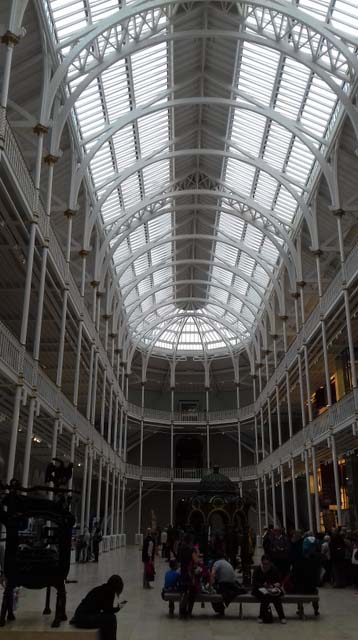
|
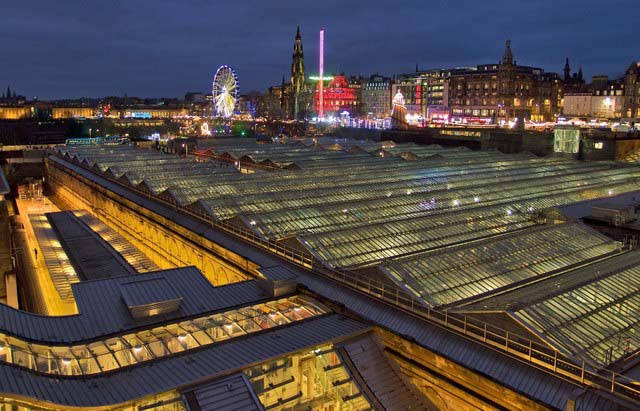
|
|
|
|
|
|
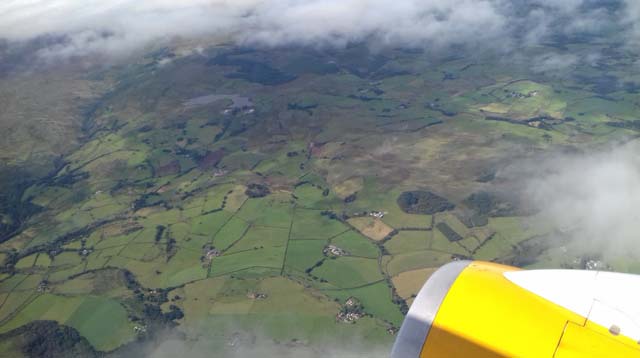
|
A Trip to Applecross is an interesting 32-bar reel for two couples that is danced with men’s chain on the first time through and ladies’ chain on the second time through. This is the only dance of all the RSCDS book dances that requires a 3-couple set for the 2-couple dance, compared with other 2-couple dances that are danced in a 4-couple set.
RSCDS has posted the demo video at:
https://www.youtube.com/watch?v=11Wd8JJMSAc.
We can access the crib and diagram for the dance at http://my.strathspey.org/dd/dance/17141/ or we can purchase the E.BOOK 50 from the RSCDS online shop at https://www.rscds.org/shop.
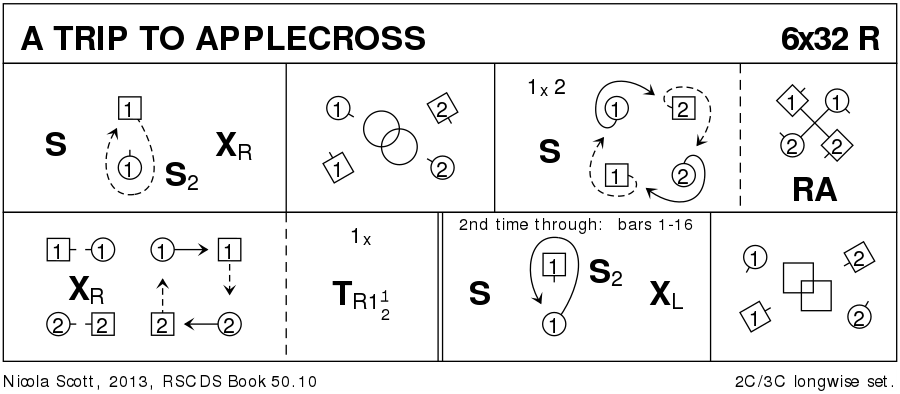
Haggis “appears to have found its way to Scotland via Ancient Greece, Rome, France and England, but until Burns there was nothing particularly Scottish about it. Recipes appear in English cookery books at the same time the ‘Address’ was written. But Burns strikes the celebratory note, dear to Scottish hearts, while at the same time honoring something which has little, if any, visual appeal. It was appropriate that he should celebrate a haggis. Do not judge by appearances, he says. Honor the honest virtues of sense and worth, not in French ragouts and fricassees, but in a more democratic dish which makes the least attractive parts of an animal into something worth celebrating.
Around 1801, five years after his death, the first Burns club was formed in Greenock. In 1805 Paisley had formed a club, and two years later Kilmarnock.
The Edinburgh literati, including Sir Walter Scott and Alexander Boswell, son of the biographer James Boswell, had their first Burns celebration in 1815 and resolved to have one every three years. In London, Scots along with some English poets had a Burns anniversary supper in 1819. But it was not until 1885 that The Burns Federation was formed with 51 Burns Club members.
In the two centuries since his death a worldwide cult has developed with deep roots founded on the poet’s appeal, not just to the literati, but to everyone. Though there may be greater poets, none have surpassed Burns in touching the spirit which bonds people of all nations, creeds and colors. For Scots, he is among a handful of makars who have written from the heart in their own tongue, adding an emotional nostalgia to Burns suppers with the color and character of the rarely heard native Scots language.
The proceedings for the night may be formal or informal. A formal supper organized by a Burns club begins when all the guests are seated with a piper entering the room, followed by the cook or chef carrying the chieftain haggis – from 5-10 kg (10-20 lbs) – on a large ashet. Behind him comes the waiter with a bottle of whisky. The procession then walks sunwise round the company, ending up at the chairman of the club, who takes the whisky from the waiter and pours out two glasses. The piper stops playing, the haggis is placed on the table and the piper and the chef are given whiskies.
A guest then recites ‘The Address’, plunging a dirk into it and cutting a St Andrews Cross on the top, turning back the flaps and inserting the serving spoon. Before the meal begins someone will recite Burns’ Selkirk Grace:
Some hae meat, and canna eat,
And some wad eat, that want it,
But we hae meat and we can eat,
And sae the Lord be thankit.
The meat for the meal, besides the haggis, should be in keeping with the festive fare of hamely folk, the traditional menu can be written in Scots and might include: Het Kail (a broth); Caller Fish (fresh fish); The Haggis; Het Joints (meat or poultry, usually roasted): Ither orra Eattocks (sweets and puddings): and Gusty Kickshaws (hot savories).
The meal over, there are the toasts, accompanied by glasses of whisky. Firstly The Queen, proposed by the Chairman, followed by The Immortal Memory, proposed by the guest of Honor. There may be other informal toasts, but there is usually a formal proposal and reply to both The Guests and The Lassies. The evening’s entertainment continues, usually dominated by Burns songs. The ending is a communal singing of Auld Lang Syne when everyone joins hands in a circle and when the fifth verse is reached – And there’s a hand, my trusty fiere – everyone crosses their arms in front and grasps their neighbor’s hands again, thus contracting the circle. As people come closer together, they move their arms rhythmically up and down, and at the end giving a rousing three cheers for auld acquaintances, the world o’er.
Haggis – Though the method has remained more or less constant over the years, the ingredients have varied. Fifteenth-century recipes use the liver and blood of the sheep, while later in the 17th century a meatless Haggas Pudding in a Sheep’s Paunch uses parsley, savory, thyme, onions, beef suet, oatmeal, cloves, mace, pepper and salt, sewn up and boiled; served with a hole cut in the top and filled with butter melted with two eggs.
Another recipe uses a calf's paunch, and the entrails, minced together with grated bread, yolks of eggs, cream, spices, dried fruits and herbs, served as a sweet with sugar and almonds. Meg Dods has what she calls a 'finer haggis', made by parboiling and skinning sheep’s tongues and kidneys, and substituting these minced, for most of the lights (lungs), and soaked bread or crisped crumbs for the toasted meal (oatmeal).
Note from Mel: Meg Dods was the purported author of ‘The Cook and Housewife’s Manual’ which was first published in Edinburgh in 1826 and went through 19 editions. However, Meg was actually a character in Sir Walter Scott’s novel ‘St Ronan’s Well’ and the author was in fact the journalist and editor Isobel Christian Johnston.
Calendar of Events | |||||
|
|